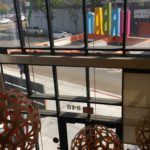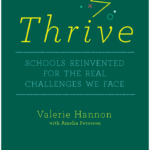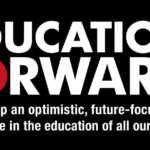For the past three days, I’ve been taking a group of school leaders and teachers around some of the most innovative schools in the United States. We curated the visit to concentrate upon Silicon Valley, primarily because the startup culture and spirit of enterprise that has made this region boom, has impacted upon the re-design of education – so long as you know where to look. It’s also a place where the jobs of the future are being created in the knowledge economy.
Unsurprisingly perhaps, this spirit of innovation is found more commonly in independent schools. I wish that were not the case, but public schools here face many of the same constraints that curtail risk-taking in public schools everywhere. Later in the study tour, we’ll be looking at charter schools – where there is greater accountability than in the private sector.
The three schools we’ve visited – Monte Vista Christian School, near Watsonville (about an hour west of San Jose), Nueva School, San Mateo (near Palo Alto) and Alt School in San Francisco – have shown extraordinary generosity with the time and a genuine interest in what our international group of educators thought about their respective missions. As a result, the learning has already been immense.
Rather than give a school-by-school breakdown, it makes more sense to look for commonalities and trends. Here’s what has struck me so far:
Use of space: all three schools get the idea that kids can only learn well if they are comfortable – physically, emotionally and spiritually. Monte Vista is set in spectacular countryside. Despite its proximity to Silicon Valley, this is farming country, between the mountains and the sea. But Monte Vista is also in the throes of turning what were very traditional classrooms into spaces that feel more like family living rooms. Similarly, Nueva’s elementary and middle schools are set in beautiful grounds, with accommodation that’s a mix of the old and the
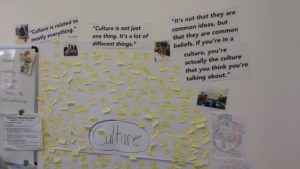
3rd Graders at Nueva discuss Culture – yes, 3rd graders…….
new. This has clearly had a profound effect on both Monte Vista and Nueva. Both have been around in excess of 50 years, and recognise their tradition and founding visions, but they’re not enslaved to them. Both were radical innovations in their creation, and they’re determined to keep innovating.
Ownership of learning : all three schools believe that students need to own their learning for it to prepare them for a lifetime of learning. At Nueva’s Upper School, half of the senior student’s schedule is made up of electives. And the choice is truly impressive: Social Justice, Experimental Biology, Drug Design, Machine Learning, Modern Film Making, Cultures of Postmodernism, Neuroscience and many more. Nueva’s Upper School felt more like a university than a school, and some students can gain university credit – not least because some of the student research work is at least undergraduate standard. Some students have been working on CRISPR gene editing, while others are carrying out original research into the P53 tumour suppressor protein. Nueva is a selective school, but the bar isn’t set at prohibitively high levels, and their students are doing really important research work, way in advance of standard common core standards.
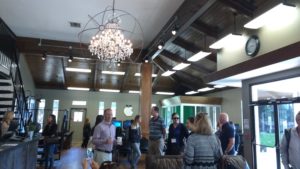
Our educators meet in Monte Vista’s ‘library’
Alt-School essentially exists to shift learning from being teacher-centric to learner-centric. Founded by Max Ventilla – former senior product manager and head of personalisation at Google – it is a stunning example of the startup entrepreneurial culture of Silicon Valley, both in its ambition and its seriousness. Alt-School have 7 lab schools that work closely with over 50 tech engineers, all committed to truly personalising the student experience. It’s a ‘for-profit’ that is determined to have social impact in making learning competency-based, owned by students and embedded in a network of supportive relationships with parents and community. We saw the first beta version of the hugely impressive software platform that will be launched next year. It provides a 360 approach to a student’s learning: curriculum, pedagogy and assessment. As you’d expect from a former Googler, every is open, so parents are critically involved. But it is designed to enable the student to work out what they need to know, and how to find it, using the ‘playlist’ concept. Max is the brains behind the Google sidebar recommendations/ads tailored specifically to your previous interactions, so you can expect a learning management platform that is far more sophisticated than anything we’ve seen before, and one which will take full advantage of the network effect. When large numbers of students are using this platform (and Alt-School is soon to make its system widely available to schools in the public sector) we will have the most powerful dataset of how students learn, but also what pedagogies should be used in a range of contexts and conditions. It will make current ‘what works’ methodologies look primitive in comparison.
Making time and space for innovation: all three schools firm
ly believe in modelling the collaboration we look to see in student work, through adult learning. Monte Vista have a new principal, Mitch Salerno, who is building a real community of adult learners. So, our visit was seen less as a ‘show-and-tell’ and more of a great opportunity to learn from the Romanian, Indian, Australian and British educators in our group. Equally, we visited Nueva a couple of weeks before their conference around innovation in learning – run largely by parents. While we were visiting Nueva, Scott Swaaley was taking parents around their i-lab spaces – these are extraordinary places (it diminishes them to describe them as merely ‘makerspaces’) originally created by David Kelley of Ideo. So, design thinking infuses throughout their practice, fuelled by their close association with Stanford’s ‘d-school’ lab.
In order to stay fresh, Nueva hire in subject specialists as well as accredited teachers. They believe that, if you’re future-focussed, it’s easier to train teaching knowledge than subject expertise. So, they have a sophisticated internal training programme, and make the time for it through reduced teaching loads.
Similarly, Alt-School is a living laboratory to study teaching and learning behaviours and impacts. Every interaction between teacher and student is videoed and analysed. It then ad
ds to the growing database they have that informs continuous conscious performance improvement.
These are just three ways that innovative schools in California are looking to the future needs of students and in building systems at scale. I could talk about their attitudes towards building self-sufficiency, compassion, social purpose in their students, but that can wait for a later post.
These three schools are remarkable examples of what can happen when you abandon false restrictions of what students are capable of achieving. They are all fee-paying, independent schools, but there’s much to learn, and much to be applied in the public sector, from what they are doing.
The next post will examine schools that straddle private and public sector divides.
Related Posts
Also published on Medium.


